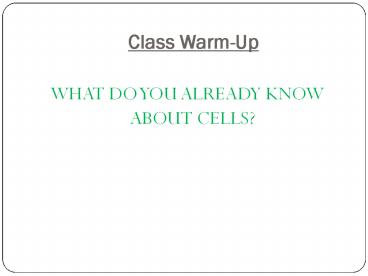Class Warm-Up PowerPoint PPT Presentation
1 / 23
Title: Class Warm-Up
1
Class Warm-Up
- WHAT DO YOU ALREADY KNOW ABOUT CELLS?
2
Cell Structure and Function
- Chapter 7.1 Life is Cellular
3
The Discovery of the Cell
- Robert Hooke
- 1665
- Englishman
- Looked at a slice of cork
- (plant material) under an
- early microscope
- Found the cork was made up of thousands of small
chambers - He called these chambers cells
4
The Discovery of the Cell
- Anton von Leeuwenhoek
- 1674 Holland, The Netherlands
- Considered to be the Father of Microbiology
- First to observe living microorganisms using
- a microscope
- Bacteria
- Protists
5
Microscopes Over the Ages
6
Co-Founders of The Cell Theory
- Matthias Schleiden, Botanist, 1837
- All plants are made of cells.
- Theodor Schwann, Physiologist, 1838
- All animals are made of cells
- Rudolf Virchow, 1858
- All cells are made from the division
- of existing cells
7
The Discovery of the Cell
- The Cell Theory
- All living things are made up of cells.
- Cells are the basic units of structure and
function in living things. - New cells are produced from existing cells.
Cells the basic unit of life
8
Class Warm-Up
- "an unbelievably great company of living
animalcules, a-swimming more nimbly than any I
had ever seen up to this time. The biggest sort.
. . bent their body into curves in going
forwards. . . Moreover, the other animalcules
were in such enormous numbers, that all the
water. . . seemed to be alive." - Which scientist that we discussed yesterday
would have said this? How do you know?
9
Compound Light Microscope
- Use lenses to magnify the image of an object by
focusing light - Cell structures as small as 1 millionth of a
meter - Magnification up to 2,000x
- Classroom microscopes go up to 400x
How Big? Animation
10
Magnification
11
Exploring the Cell
- Why are chemical stains/dyes used in microscopy?
- Most living cells are nearly transparent
- Stains allow the cells to be seen under the
microscope - Some reveal only certain compounds and structures
within the cell - Fluorescent dyes
- Different colors attached to different
- molecules
- Allows scientists to observe how
- materials move throughout the cell
12
Dissecting Microscope
- Also referred to as the stereo microscope
- designed for low magnification observation of a
sample, typically using light reflected from the
surface of an object rather than transmitted
through it. - 3D images
- used to study the surfaces of solid specimens or
to carry out close work such as dissection,
microsurgery, watch-making, and circuit board
manufacture or inspection
13
Electron Microscopes
- 2 types Transmission (TEM) and Scanning (SEM)
- Sends an electron beam through a vacuum to
illuminate a specimen and produce a magnified
image - Smaller cell structures as small as 1 billionth
of a meter - DNA
- Protein molecules
- Viruses
14
SEM vs. TEM
- SEM (Scanning Electron Microscope)
- 3D images
- up to 200,000x magnified
- focuses the electron beam to a very small point
on the sample and scans over the sample to
produce an image
- TEM (Transmission Electron Microscope)
- sends an electron beam through a thin sample,
projecting an image on a fluorescent screen - Cannot view the surface of specimens
- Up to 50 million times magnified
Cool Electron Microscope Images
15
Types of Cells
- Prokaryotic Cells cells that do not contain a
nucleus
- Eukaryotic Cells cells that contain a nucleus
A
B
Nucleus a large membrane-bound structure that
contains genetic material (DNA) and controls many
of the cells activities
16
Prokaryotes Eukaryotes Both
No nucleus Smaller and simpler cells No membrane bound organelles Most primitive form of life on Earth Example Bacteria Nucleus Larger and more complex cells Have membrane bound organelles Examples Plants Animals Fungi Protists single celled (unicellular) organisms Cell membrane DNA Ribosomes Cytoplasm Cytoskeleton
17
WOW!!!
- One cell has 2 meters of DNA.
- If all the DNA in your body was put end to end,
it would reach to the sun and back over 600
times! - Your body has about 75-100 trillion cells!
- 90 of those cells are bacteria cells!!
- They can live as short as a day to as long as a
year!
18
Formative Assessment
- Learning Goals
- Explain the 3 parts of the cell theory.
- Describe the differences, similarities and
evolutionary links between prokaryotic and
eukaryotic cells.
19
Which of the following statements are true?
- All living things are made up of cells
- Cells are the basic unit of structure and
function - New cells are produced from existing cells
- All of the above
20
What is a membrane bound structure that contains
genetic material and controls many of the cells
activities?
- Prokaryote
- Eukaryote
- Nucleus
- Cell membrane
21
Which of the following cells do not contain a
nucleus?
- Animal cell
- Plant cell
- Bacterial cell
22
Both prokaryotes and eukaryotes
- have a nucleus
- have DNA
- have membrane bound organelles
- are the same size
23
True or false? Eukaryotes are cells that do not
have a nucleus.
- True
- False

